In December 1952 Canadian military Exercise Reluctant Beaver took place at Kloo Lake in the southwest Yukon, one of a number of exercises carried out in this region in the early 1950s. This was during the peak of the Cold War, a time of worldwide stress created by strained relations between the United Stated and the Soviet Union following World War II.
Reluctant Beaver was an 11-day exercise to familiarize and train Canadian military personnel to operate in northern winter conditions. Specifically, it involved a newly-formed troop of airborne combat engineers, the first such unit in the Canadian Army, and the tasks entailed parachute drops of personnel, equipment, and provisions. This was followed by the building of an ice airstrip on Kloo Lake, a bridge over the Jarvis River, a bush road, camps for personnel, and shelters for equipment.
This article had its beginning when I saw a report about Exercise Reluctant Beaver at Library & Archives Canada in Ottawa. I was aware of a couple of military exercises that had taken place in the Kluane Lake area, but I had never heard of this one so close to where I have lived for a long time. I subsequently found a number of newspaper articles that appeared across the country while the exercise was going on.
The information about Exercise Reluctant Beaver at Library & Archives Canada indicates a holding of 36 photos that were taken during the event. Some of these were shared with the newspapers and appeared in their articles, particularly in the Calgary Herald which had a knowledgeable reporter on site.
The exercise report and the newspaper articles give the impression that the only people living in the southwest Yukon were personnel connected with the Canadian Army’s operation and maintenance of the Alaska Highway. There was no reference to contact or communication with local people, including a Canadian Rangers unit that was active at Destruction Bay, less than 50 miles up the highway. More significantly, there was no mention that Exercise Reluctant Beaver was conducted on the doorstep of the First Nation village at Kloo Lake. This lack of interaction may be why there seems to be little local memory or knowledge of Exercise Reluctant Beaver.
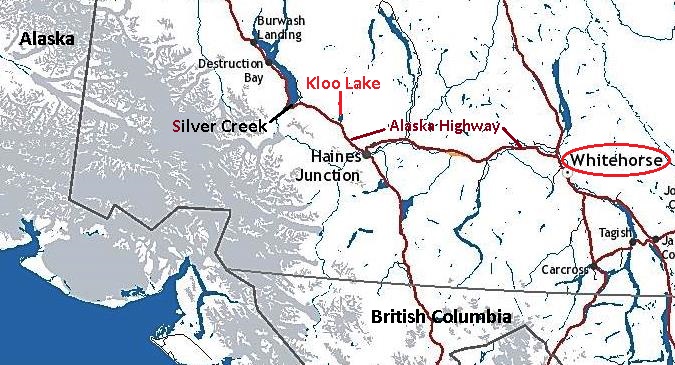
(GeoYukon)
Geographical and Historical Context
Exercise Reluctant Beaver took place at Kloo Lake, just north of the Alaska Highway 18 miles northwest of Haines Junction. The lake is drained at its south end into the Alsek River watershed by the Jarvis River, which is bridged by the highway at what is now kilometer 1608 (mile 1034.5 in 1952). The highway had been built through the area in 1942, more or less following the Kluane Wagon Road that was constructed in 1903 from near Whitehorse to Silver City on Kluane Lake.
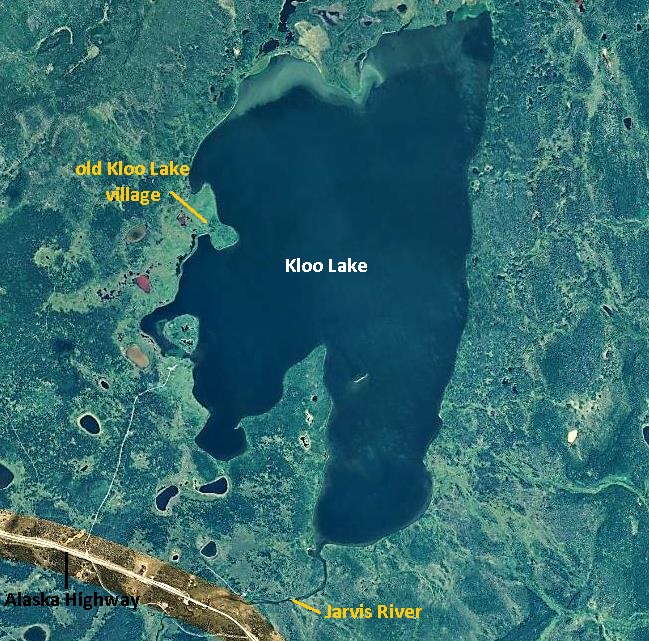
(GeoYukon)
The nearest developments to the south along the Alaska Highway from Kloo Lake in 1952 were the Mackintosh Trading Post at Bear Creek, 12 miles away, and Haines Junction, 18 miles away. The trading post had been established in 1903 on the Kluane Wagon Road, 40 years before Haines Junction got its start as a Haines Road construction camp. By 1952 Haines Junction was developing as a community with businesses and government services. To the northwest of Kloo Lake, the settlement of Silver City that had been recently abandoned was 18 miles distant and the highway maintenance camp at Destruction Bay was 49 miles away.
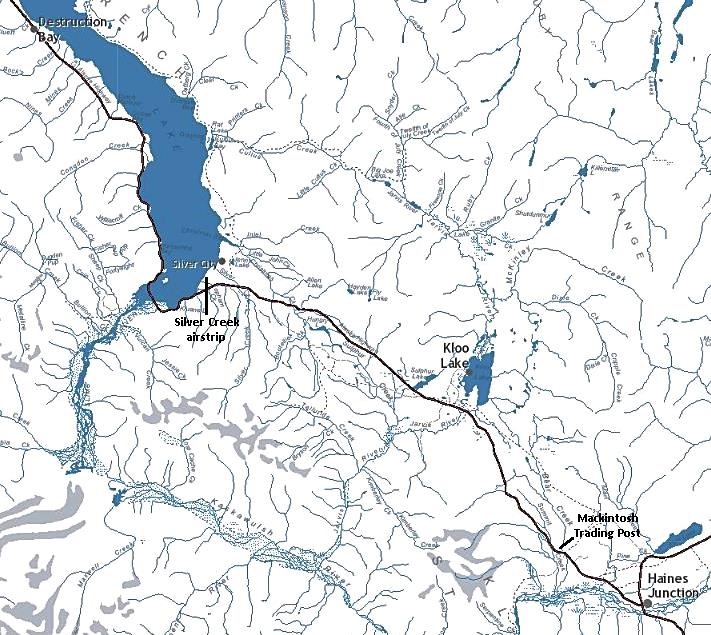
(GeoYukon)
Kloo Lake’s name is derived from the Champagne & Aishihik First Nations’ Southern Tutchone name of K’ùä Män, meaning ‘whitefish lake’. The local First Nation people’s experience with outsiders coming into the country began in 1891, when explorers Edward Glave and Jack Dalton passed through with horses.
In 1903 gold discoveries on creeks north of Kloo Lake brought many prospectors into the area and a wagon trail was constructed on the west side of the lake. The Jarvis River roadhouse was also built at this time south of the lake, near the Kluane Wagon Road crossing of the Jarvis River. In 1923, when automobile traffic began using the wagon road, a bridge was built over the river near where Exercise Reluctant Beaver would also build one nearly 30 years later.
Around 1917 a fur trading post was established on the trail about halfway up the west side of Kloo Lake and remained in business until 1947. Half a mile south down the lake from the post site was the First Nation village, where in December 1952 Exercise Reluctant Beaver landed in their front yard.
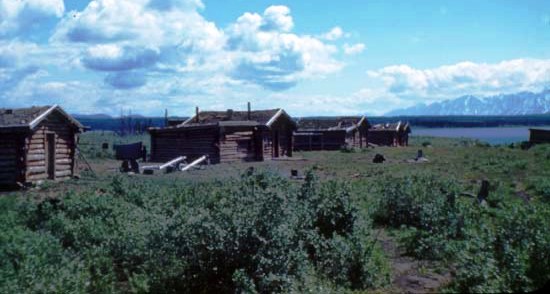
(Yukon Archives, Robert Cartter fonds, Acc. 82/281R, #1609 – photo has been cropped)
Nationally, the historical context revolved around the Cold War, a period of global tension between the United States and the Soviet Union and their respective allied countries that arose in 1945 after the end of the Second World War. This time of strained relations due to ideological differences had its peak during the years 1948 to 1953 and started to gradually diminish in 1961, but did not end until the collapse of the Soviet Union in 1991.
The Cold War saw no direct fighting between the American and Soviet superpowers, but there were regional conflicts, particularly the Korean War that started in June 1950 when North Korea invaded South Korea. North Korea was supported by the Soviet Union and China, while South Korea was backed by the United States and a large number of allied countries, including Canada. While Exercise Reluctant Beaver was being held in the Yukon, Canadian soldiers were fighting and dying in Korea, where the war there did not end until July 1953.
Other Military Exercises
It was against this backdrop of the Cold War and Korean War that Canadian and American armed forces, fearing a possibility of invasion by the Soviet Union from the northwest, conducted training and familiarization exercises in the southwest Yukon (referred to as ‘frozen wastelands’ in some newspaper articles). At least five of these were carried out in the first four years of the 1950s, some of them joint exercises and some solely Canadian.
Operation Sweetbriar was the first and also the largest exercise, involving more than 5,000 allied personnel, 1,000 motorized vehicles, and 100 aircraft. It was conducted over the course of 11 days in February 1950 to develop techniques for the combined Canadian and American forces to operate in sub-Arctic conditions. The scenario for Sweetbriar was that the Communist forces had invaded Alaska from the west, and the task of the allied forces was to drive them back from advancing into the Yukon. This exercise began three weeks after the disappearance of the US Air Force’s Douglas C-54 Skymaster #2469 in the same general area of the Yukon with 44 people aboard that has never been found.
Other exercises were conducted over the next few years, with names like Eager Beaver, Reluctant Beaver, Hot Dog II, and Mule Team. All except Reluctant Beaver were based at the south end of Kluane Lake and carried out similar activities to become familiar with operating in northern winter conditions. At least two of the exercises involved members of the Canadian Rangers group based at Destruction Bay. One of them, Ken Baltimore, said that he and Gordie Atkinson participated in an exercise at the Kluane Lake camp during some cold weather, and Ken’s main memory is that the sleeping bags they were issued did not pass muster.
Charlie Eikland Sr. from the Beaver Creek area lived in Haines Junction during his school years and has some memories related to the military exercises. He recalled walking along the Alaska Highway to school with his sister one day when a stream of military vehicles passed by and the soldiers threw candy out to them. He also remembered the Alaska Highway being gated at Kluane Lake during the exercises and travellers having to check in with military authorities there. Charlie was aware of the Reluctant Beaver exercise at Kloo Lake and thought that a paratrooper was killed there, but if so I have not seen a record of it.
Participants
In 1948, four years before Exercise Reluctant Beaver, the Canadian Army had formed the Mobile Strike Force (MSF), an airborne brigade designed to respond quickly to a land and air threat arising from the Cold War. It was realized, however, that they needed to involve combat engineers (also known as sappers), who perform tasks in support of the front-line infantry. Combat engineers “ensure that troops can live, move, and fight on the battlefield. They also perform construction and maintenance tasks, operate vehicles and equipment in support of engineer operations, and maintain field installations and facilities.”
Since the Mobile Strike Force was an airborne brigade, it was recognized that the combat engineers also needed to be airborne, rather than delivery by other means of transport. In January 1952, #1 Airborne Troop of the Royal Canadian Engineers (RCE) was formed at Chilliwack, BC, to address this need, the first such unit to be created. Exercise Reluctant Beaver was planned as a training exercise primarily for the new #1 Airborne RCE troop later that year.
The participants in Reluctant Beaver from the Army were to be 58 parachutists of all ranks from the #1 Airborne RCE and 20 personnel from #1 Airborne of the Royal Canadian Army Service Corps for logistical support. From the Royal Canadian Air Force there were aircraft and personnel from 435 Squadron in Winnipeg who would be based in Whitehorse for the exercise.
A ‘neutral camp’ was established at the Silver Creek airstrip on Kluane Lake using shelters left behind months previously by Exercise Eager Beaver. The camp was for a medical facility, a base for ‘winter indoctrination’ training, and accommodation for supervisory and support personnel not involved at the exercise site. Transportation including ambulance service was supplied by the Northwest Highway System maintenance personnel.
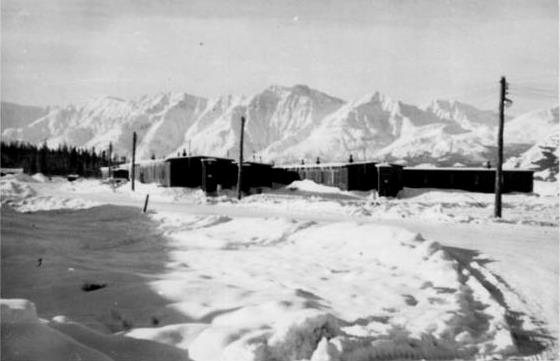
(Sylvia Lefferson photo, provided by Marilyn Brewster)
Planning and Preparation
Planning of the exercise began in April 1952 and approval was granted in May. This was followed by a site visit in early June and then a planning conference later in the month. The 11-day exercise was scheduled to begin during the window of November 20 to December 7, with the starting date dependent on weather conditions.
Pre-exercise training through the fall months consisted of packing and loading of aircraft at Chilliwack, winter indoctrination training at Silver Creek, and heavy equipment operator training at Whitehorse given by Northwest Highway System personnel. Equipment and provisions were shipped from Chilliwack to Whitehorse in October and the personnel arrived in November.
Scenario and Exercise Plan
The scenario given was that with the element of surprise, Alaska was invaded by Communist air and sea forces, which were able to dominate the region from centers at Fairbanks and Anchorage. Some units of the allied forces were intact but cut off from their bases, severely limiting offensive action. Enemy forces from Fairbanks were moving east on the Alaska Highway and approaching Snag. The Canadian Mobile Strike Force based its personnel and equipment at Whitehorse and planned to mount an offensive to dislodge the enemy and establish a defensive framework at Kluane Lake.
Criteria for the area selected for Exercise Reluctant Beaver were that it had to be within logistical support of Whitehorse, which would be the marshalling area for the troops and equipment and the base for the initial air transport to the exercise site. The location also had to be where there was a lake suitable for constructing an airstrip and an access road could be built from the Alaska Highway to it.
Kloo Lake was chosen for Exercise Reluctant Beaver, and separate drop zones on the lake were identified for airdropping of personnel and equipment (except heavy equipment) and an area of the lake was selected for the airstrip. An additional drop zone on land was identified close to the highway near where a bridge construction camp would be established.
An assault base headquarters would be placed beside the highway and be equipped with radio and a telephone line to the base at Silver Creek. A Bridge Camp would be set up close to the highway where the bridge over the Jarvis River was to be built, and what was termed a HQ Camp established beside Kloo Lake near the planned ice airstrip.
Objectives and Tasks
The objectives of Exercise Reluctant Beaver were:
- to exercise #1 Airborne Troop Royal Canadian Engineers in engineering tasks in support of a typical MSF winter operation in an isolated area using only equipment which could be airdropped;
- to test the adequacy of the equipment proposed for use by the Airborne Troop; and
- to test the feasibility of proper maintenance of equipment using the minimum shelter requirements, either made from local resources or airdropped.
The Troop was given the following tasks:
- to construct a temporary ice airstrip capable of use by assault phase aircraft Fairchild C-119G (Flying Boxcar) or C-123 (Provider);
- to construct an access road of prescribed specifications to the Alaska Highway, including construction of an improvised bridge;
- to install a water point capable of supplying water for up to a brigade (3,000-5,000 personnel); and
- to demolish the temporary ice airstrip upon completion of the exercise.
These objectives and tasks would involve airdropping of personnel and equipment of the Airborne Troop (except special engineer equipment) and preparation of camp and bivouac areas.
Command
The command and control functions for the exercise were in the hands of representatives of the Army’s General Officer Commanding (Western Region) and the Northwest Highway System commander, both based in Edmonton. One officer from the Engineer troop was to be Chief Umpire for the exercise and there would be a Drop Zone umpire along with four checkers/dispatchers for the initial parachute drop.
The Drop Zone umpire had the responsibility of calling off the initial parachute drop if conditions were unsuitable, particularly winds above 18 miles per hour. The Chief Umpire had the ability to call off subsequent drops if necessary.
D-Day and D+1 – The Personnel Drops
The weather was unusually warm in the early winter of 1952 and the ice on Kloo Lake was slow to thicken in the lead-up to Exercise Reluctant Beaver. A telegram on November 10 suggested that the event be postponed until December 10, and added that it could be shortened two or three days if necessary so that all personnel could be returned home for Christmas, which was deemed important for morale reasons.
It turned out that December 2 was the day the exercise was initiated, when the ice on Kloo Lake was only 12 inches thick with a few inches of snow on top and the temperature was relatively mild. This was termed D-Day, and the subsequent days were called D+1, D+2, etc. (this article will use the more straightforward terms Day 2, Day 3, etc.)
At first light on December 2 (D-Day), a Douglas C-47 Dakota aircraft left Whitehorse and an hour later was 95 miles to the west over Kloo Lake. The weather was warm with no wind and there was about three inches of snow on the lake surface. What was termed a ‘recce’ (reconnaissance) party of 14 paratroopers jumped safely from 700 feet onto the ice of the northwestern part of Kloo Lake. This group packed up their parachutes and hiked south for 2.5 miles across the lake and another 1.5 miles down the Jarvis River to where they set up their camp near the planned bridge site. Along the way they scouted out the locations for the supply drop zone, the airstrip, a camp site near the airstrip, and the bridge.
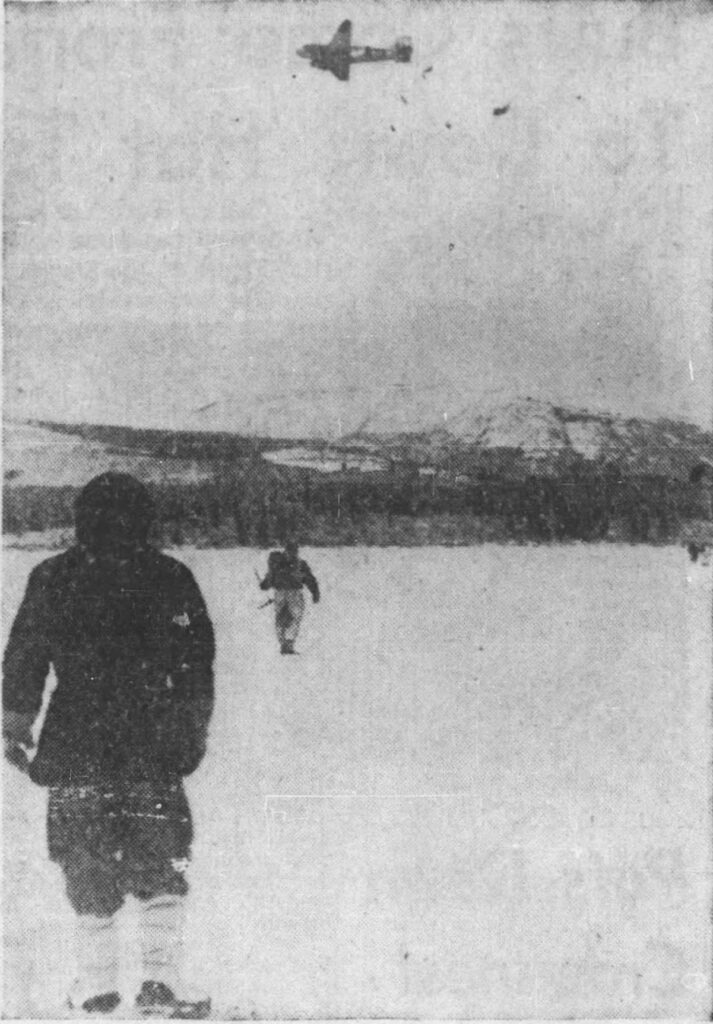
(Canada Dept. of National Defence, in Calgary Herald, 16 December 1952)
The Dakota went back to Whitehorse and returned with a second drop of 13 troopers, who then walked south a little over a mile to a peninsula on the lake. There they got to work clearing an area and setting up the HQ Camp in the limited daylight that would have remained. There was no communication between this camp and the Bridge Camp, and the distance between them was about a 40 minute walk.
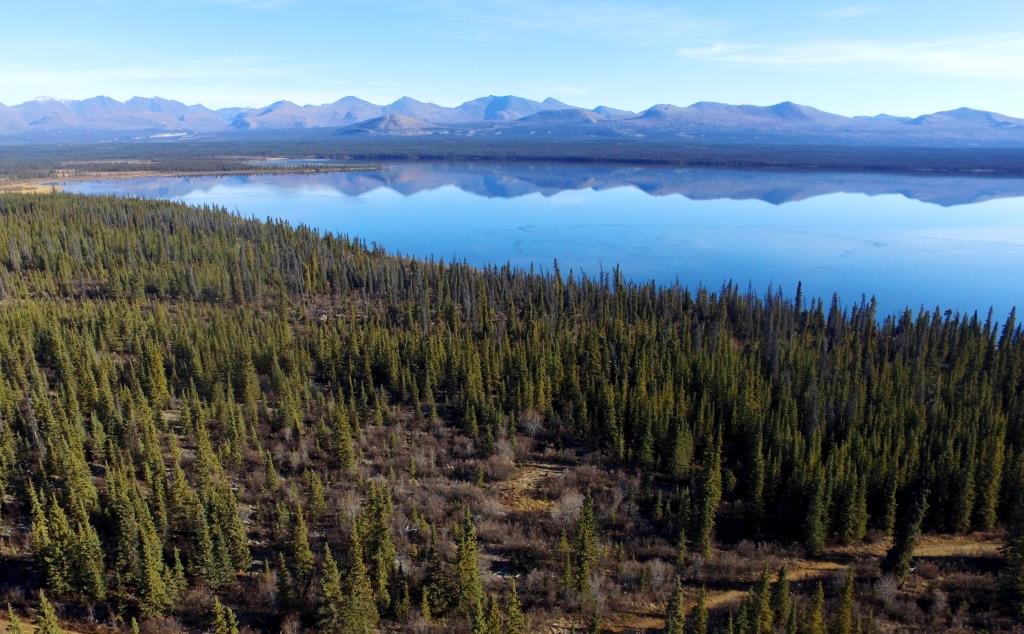
(Neal Allison photo)
The next day (D+1, or Day 2) the weather was the same and two more drops were made in the afternoon, this time from 800 feet. The first drop consisted of 13 men and the final personnel drop of the exercise was eight men, for a two-day total of 48 jumpers. By the evening they were all settled in their respective camps to begin the exercise on the ground the next day.
Three men from the first day’s jumps ended up with severe bruising due to hard landings on the ice, requiring them to be taken to the medical facility at Silver Creek. This may be the reason that the drop height for the second day was increased from 700 to 800 feet, although that day also had a jumping casualty, a twisted knee that removed that jumper from the exercise. These injuries meant that four of the 48 jumpers were out of action. Three rifles were broken on landing, a matter that required investigation since the rifles are the first line of defense for an airborne strike force.
Day 2 – The Supply “Drops” and Drop Zones
The supply drops were also carried out on Day 2, delivered from the Silver Creek base to Kloo Lake in mid-afternoon by what were termed “simulated resupply drops” in the form of two loaded 10-ton Mack trucks to “represent” two Dakota aircraft. The exercise report does not state if this was the plan all along, or if the ice of Kloo Lake was deemed insufficient to risk dropping heavy cargo loads onto it. A grader and three small bulldozers were also delivered to Kloo Lake to assist in the exercise.
Additional ground personnel arrived on Day 2 at Kloo Lake by land with the simulated resupply drops, and there ended up to be a total of 62 personnel on site. By the end of the exercise, eight had been removed, seven due to injury and one to ‘chill and shock’, but the exercise report does not state if any or all returned to work.
For the supplies, there were two designated “drop zones” (DZ), one called the ‘Bridge Site DZ’ near the highway where rations, fuel and oil, and tools required by the bridge site crew would be stored. This was situated near where this crew had their camp.
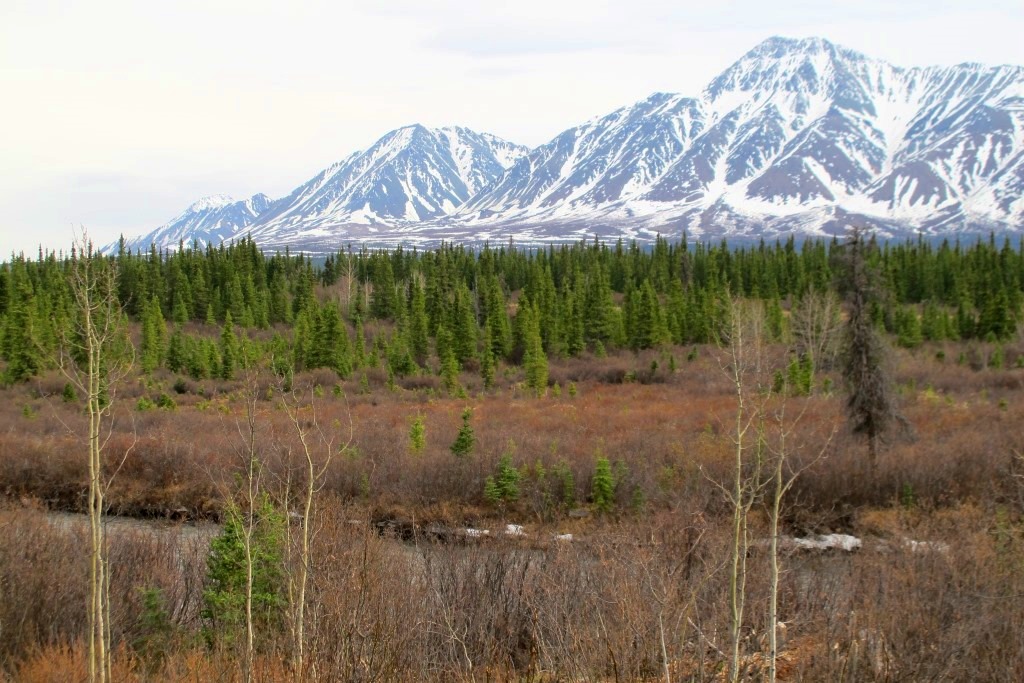
(Gord Allison photo)
The other drop zone was located on the west side of Kloo Lake and called the ‘Stores DZ’, containing the supplies for what was named the ‘HQ Camp’ where the airstrip and road building crews would work from. The sketch map in the exercise report shows this zone overlapping the lake surface and the shore at a location about a quarter-mile from the First Nation village. The exercise report does not state if or how the supplies were planned to be delivered to the Stores DZ by truck.
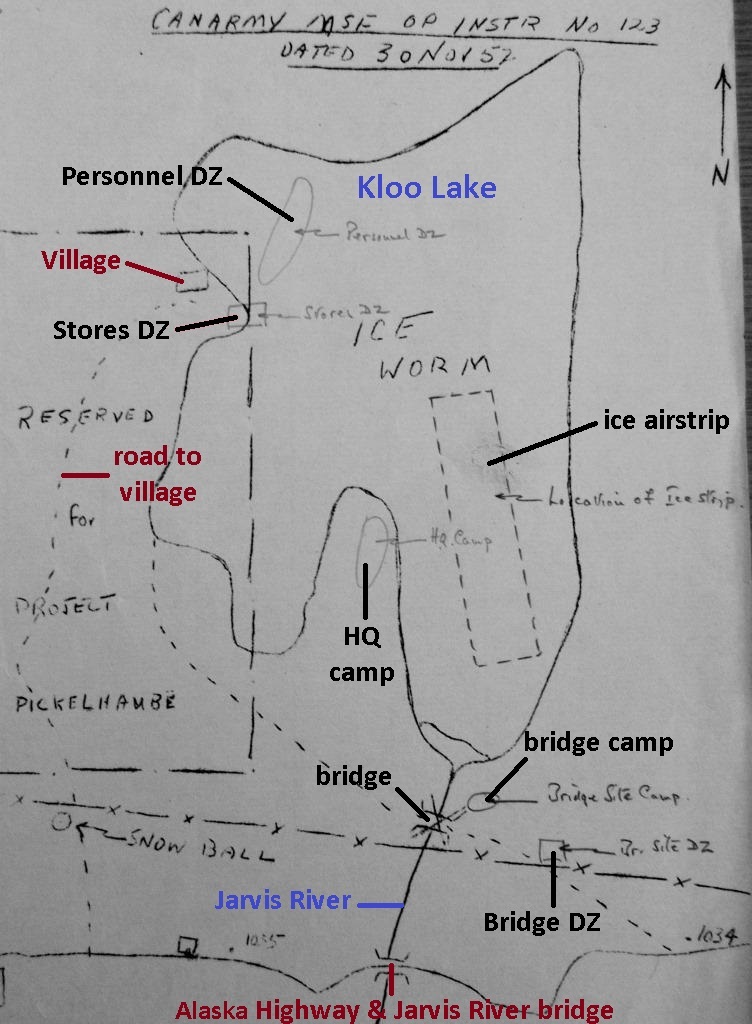
(Library & Archives Canada, RG24 Vol. 35769, File 2001-91R8)
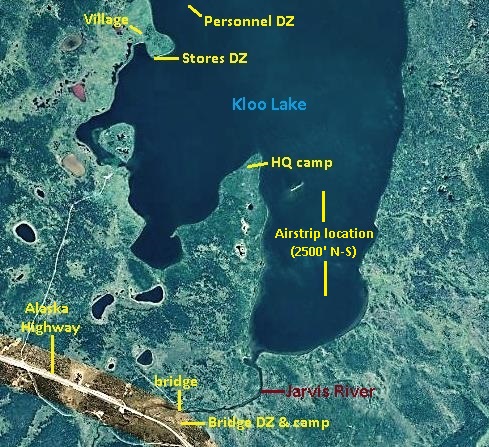
(GeoYukon)
Whatever was the plan, it went awry when one of the trucks got stuck near the highway and its entire cargo was unloaded there. Some of it was intended for the HQ Camp at the lake, over two miles away, leaving that camp without some essential supplies, including the wireless radio sets. This meant there was no communication between the camps, and the personnel who were at the HQ Camp were left in the dark about where their supplies were.
The Stores DZ Snafu
‘Snafu’ is a term that originated in the military meaning “situation normal, all fouled up” (using the more politely worded version). The unloading of supplies near the highway that were intended for the Stores DZ, located three miles away through the bush and across the lake, was the first major snafu of the exercise. It took the remainder of Day 2 and all of Day 3 to sort it out and get the right supplies from the Bridge DZ at the highway to the Stores DZ. This was accomplished by the grader and a small bulldozer pulling supplies loaded on a ‘stone boat’ that was constructed from logs.
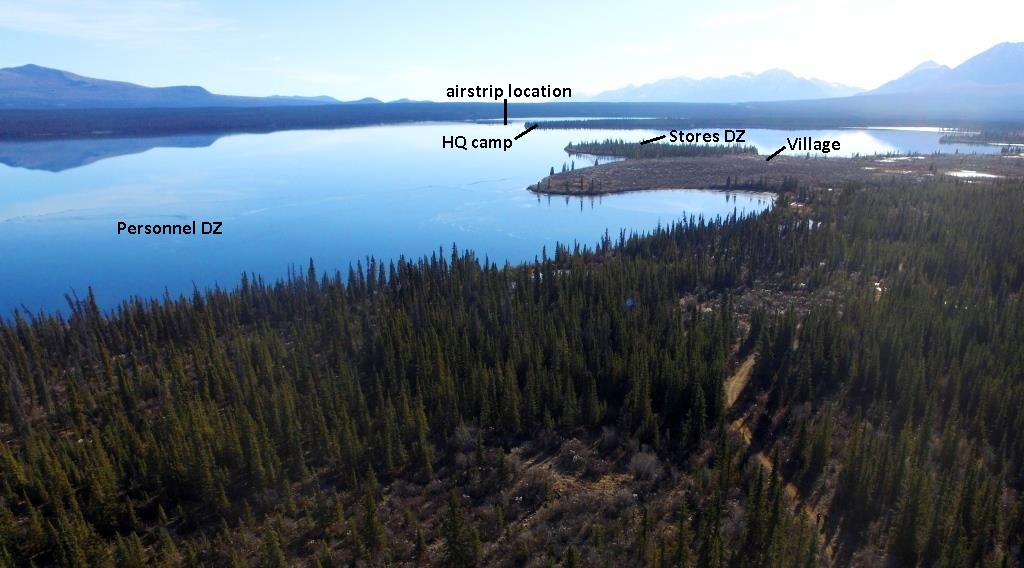
(Neal Allison photo)
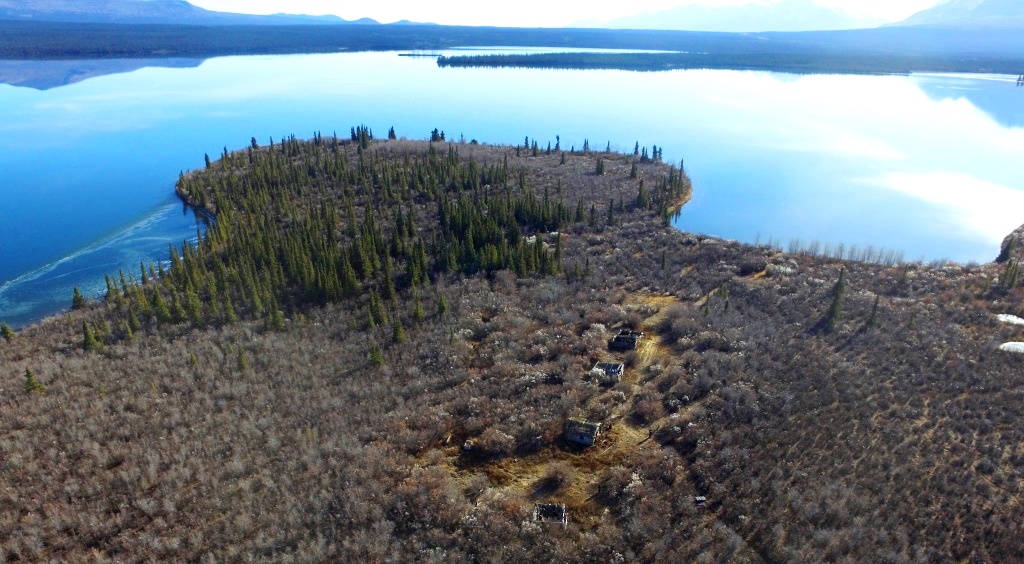
(Neal Allison photo)
The work involved with the movement of supplies to the Stores DZ by the machines was time-consuming and affected the rest of the exercise by delaying the beginning of the airstrip, road, and bridge construction by a couple of days. After the supplies were finally delivered to the Stores DZ, it was soon found that the frequent retrieval of them across the mile of ice to the HQ Camp was too inefficient because it required using the grader or bulldozer, taking that machine away from its other work.
On Day 7, all the work that had been involved in getting the supplies from the highway to the Stores DZ went for naught when the machines were again taken away from their work to haul the remaining supplies at the Stores DZ back to the Bridge DZ, where they had been hauled from five days prior. From there, supplies for the HQ Camp would be hauled as needed by machine along the newly completed road, a greater distance than when they were being taken across the ice from the Stores DZ. The rationale for this reversal is puzzling, but there may have been other factors not stated in the exercise report, perhaps the perceived safety of hauling across the ice being one.
The Heavy Equipment
The plan for Exercise Reluctant Beaver on Kloo Lake was entirely dependent on the three small bulldozers and the grader. The grader’s role was primarily to remove snow from the lake for construction of the ice airstrip, which entailed flooding it to thicken the ice. This work was delayed by the supplies snafu on Day 2 that required the grader to move them to where they were intended. The three bulldozers, also involved in the transport of the supplies, were to be used for building an almost two-mile road through the bush from the bridge site to the HQ Camp on the peninsula and for skidding and placing logs in construction of the bridge.
Two bulldozers were part of the second major snafu in the exercise. For starters, the Allis-Chalmers HD 5G, which arrived in the evening of Day 3, was useless for helping to build the road because its tracks were configured for use as a front end loader and had virtually no traction on snow and frozen ground. The next day would turn out to be a bad day, when it and another machine went through the ice of Kloo Lake in separate incidents, putting them out of commission, one permanently.
This started in the morning of Day 4, when the Allis Chalmers machine went to the Stores DZ on the west side of Kloo Lake and then was returning across the mile of ice to the HQ Camp. Within 20 yards of the shore the machine broke through 12 inches of ice and into four feet of water. The engine kept running even though the water was up to the top of it, and the machine was able to be pulled out within a few hours by a Caterpillar D-4 . The machine was put into an improvised canvas shelter in the trees where five large heaters with fans, generally known as master heaters or Herman Nelsons, dried it out. It was back in operation in the afternoon of the next day (Day 5), but later ended up out of service due to a mechanical issue that could not be addressed in the field.
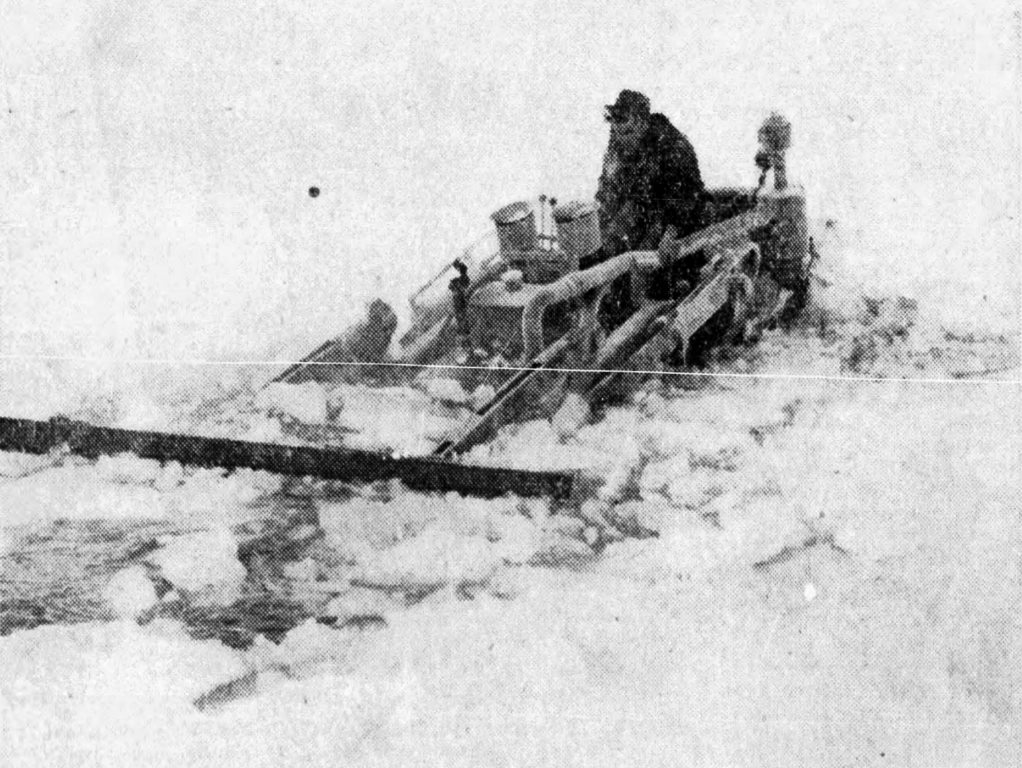
(Canada Dept. of National Defence, in Edmonton Journal, 18 December 1952)
Several hours after the Allis Chalmers broke through the ice, so did one of the Caterpillar D-4s. It left the HQ Camp on the peninsula destined for the Stores DZ across the lake to pick up a load when it broke through the ice 100 yards after leaving the shore. In dark and nearly -30°C conditions, the driver who was fully immersed was pulled out by the valiant effort of a troop mate who was riding on the sleigh. The driver was taken to the bush shelter, which fortunately was not far away, to warm up and dry out along with the Allis Chalmers. He was evacuated to the Silver Creek base the next day due to chill and shock.
With two bulldozers out of commission and the load from the Stores DZ still being needed at the HQ Camp, this was considered an emergency, and Bombardiers (tracked all-terrain vehicles) that the umpires had for performing their tasks were used for it. The main item required at the camp was fuel to keep the five heaters going in the machine shelter at the rate of 20 gallons per hour.
The D-4 had settled into more than seven feet of water, with the sleigh it was pulling still resting on the ice. There is no information in the exercise report about any attempt to pull the machine out of the water, and one newspaper article said that it would be “left until the spring thaw”, but I have found no further information. A Kloo Lake First Nation elder I talked with who was a boy at the time of this event has a vague recollection of it, but could not shed light on the fate of the D-4.
The Ice Airstrip
A 2,500-foot airstrip was planned to be built on the southeast part of Kloo Lake to a thickness that would support use by Fairchild C-119G (Flying Boxcar) aircraft. This would be done by flooding on top of the existing ice using Typhon ice drills that were being tested as part of the exercise. This equipment was capable of drilling 9-inch holes through several feet of ice, and upon reaching water the auger acted as an impeller to pump water at 500 gallons per minute.
On Day 3 the centerline of the airstrip was marked out by the grader, but before anything more could be done it was needed for the moving of supplies to the proper places. It was freed up later the following day to clear the rest of the snow from the proposed airstrip location.
On Day 5 the Typhon ice drills were put to work flooding the ice cleared off by the grader. There was some difficulty encountered, particularly with starting the gas engines on them, but once going they worked fairly well. On Day 6 a decision was made to remove the grader from the ice because cracks had begun to appear on the airstrip’s surface after repeated passes by the machine. Water was seeping through and may have caused some nervousness after the experience of the two bulldozers falling through ice.
Pumping of water onto the airstrip continued on Days 7 through 9 with what was deemed moderate success in terms of gathering information about the technique. From the beginning there had been no expectation that the ice could be built up from 12 inches thick to the 30 inches that would be required to support a C-119 Dakota airplane. The exercise report does not state how much the ice was thickened by the water pumped on during the testing, but one conclusion drawn was that when air temperatures are -18° to -34°C, ice can be built at the rate of one inch per day.
As the exercise was nearing its end, on the morning of Day 10 the ice airstrip went out with a bang when it was bombarded by explosives dropped along it from the air, sending columns of ice, water and mud shooting 400 feet into the air. This was a test and demonstration of what would be done in real circumstances to render an ice landing surface unusable by enemy aircraft.
The Road and Bridge
The building of a bridge over the Jarvis River and a nearly two-mile road through the bush from the bridge to the HQ Camp on the southern peninsula of Kloo Lake was a training exercise for the airborne troopers. The two linked projects would also serve the purpose of facilitating the demobilization of the camp at the end of the exercise.
The bridge was built at a location about 100 yards upstream of where there had previously been a bridge at the Kluane Wagon Road crossing. Work started on Day 3 with the felling of trees, and the next day preparation of the site was in full swing. By Day 6 the bridge abutments on each side of the river were in place as well as two of the trestles. On Day 7 the bridge was described as beautiful work, with timbers squared with adzes and of very substantial construction. It was deemed to be fair progress, but should have been further advanced by this point.
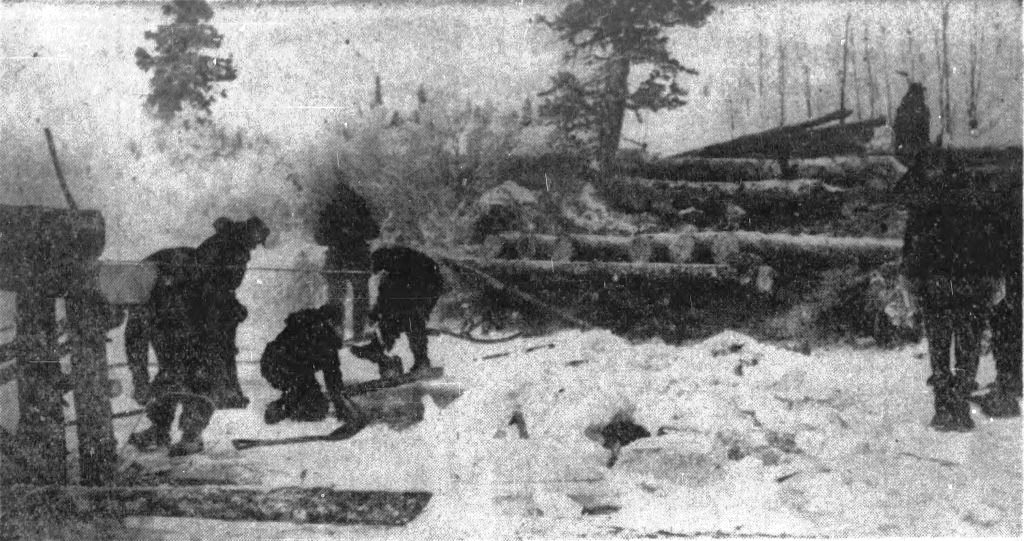
(Canada Dept. of National Defence, in Calgary Herald, 15 December 1952)
Day 8 brought about a problem for the bridge construction when river ice backed up the water so that it was flowing through and around the trestles. This was resolved by sending a bulldozer into the river to break up the ice and relieve the back-up pressure of the water.
On Day 10 the 85-foot bridge was completed in late afternoon and crossed by a Northwest Highway System 12-ton wheeled tractor. The following day, which was the final day of the exercise, it was crossed with a fully-loaded 10-ton truck, presumably with cargo from demobilization of the HQ camp over the constructed road.
The road construction had gotten off to a slow start when the machine(s) slated to build it were diverted for a couple of days to haul supplies to their designated places. Then the two bulldozers broke through the ice into Kloo Lake, one permanently and the other needing rehabilitation for more than a day. When the Allis Chalmers machine got back to work, it was found that its smooth tracks were useless for road construction, so the remaining D-4 took over.
By the middle of Day 4, the D-4 had built 300 yards of road and by Day 6 had a rough road pushed through to the HQ camp. On Day 7 it was deemed to be 50% of an adequate road, suitable for tracked vehicles only and too narrow for vehicles to pass. On the final day (Day 11) the road was inspected and found to have an excellent alignment with a level and smooth surface, but it still lacked passing places.
A 1956 air photo shows the road that was built from the Jarvis River crossing to the HQ camp site less than four years previously during Exercise Reluctant Beaver. It also appears to show the bridge constructed as part of the exercise as a light line crossing the river. This contrasts with the absence of the bridge that had been at the Kluane Wagon Road crossing of the river a short distance to the west. The Army’s bridge is no longer in place in a 1964 air photo.
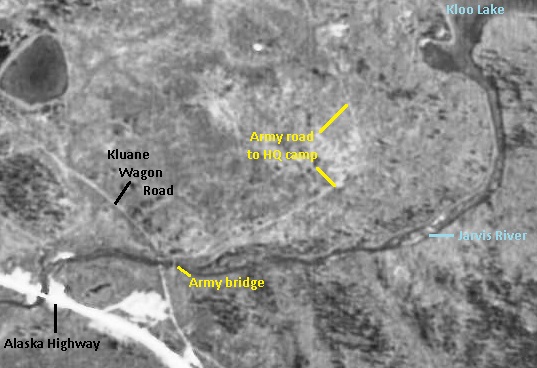
(National Air Photo Library, A15434, #3)
There are still remnants of a bridge on both sides of the river in this area, but they line up better with the Kluane Wagon Road crossing. In 1952 these remnants would have been somewhat more substantial and frozen into the riverbanks in December, which may have caused the Army to select a new crossing location rather than deal with the old bridge remains.
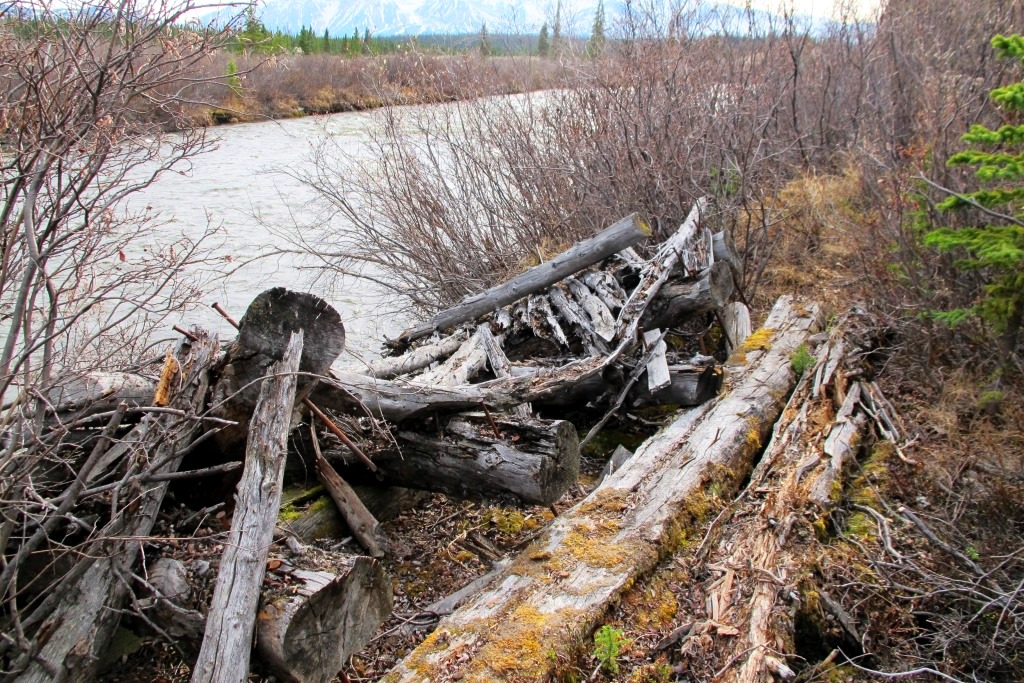
(Gord Allison photo)
Brigade Water Point
This task with the odd name was given relative prominence in the exercise goals, although not a lot of details about it were given. It is a means to provide a reliable supply of treated water to a large group of people from a single source so they aren’t using water from wherever they can get it. The water point consisted of a suction pump to fill a tank with a filtration system and delivery lines to various types of outlets.
In the Exercise Reluctant Beaver scenario, the water point was assembled beside the Jarvis River near the Bridge Camp, where water from the river was readily available and vehicles could drive up to it for transporting elsewhere. A large shelter was erected with a heater in it for storage of the water tank and lines, as well as the pump and suction hose when not in use. Ensuring a healthy water supply is not surprisingly an important consideration in military situations, both real and in exercises.
The Exercise Results
The military personnel interviewed by the newspapers painted a relatively positive picture of Exercise Reluctant Beaver, while acknowledging some of its shortcomings. Comments such as “we have learned all that we had hoped to” and “it has been most successful in an educational way” were offered, but at least one newspaper voiced a bit of skepticism.
A critique at the end of the exercise report probably expresses most of the truths. There were various points made about topics such as planning and preparation, but of interest for this article are observations about the on-the-ground activities. In short, and with some translated wording, some of these were:
- a statement about the location of the Stores DZ on Kloo Lake, far away from the camps and work sites, was worded ambiguously, but ended with the word “unreal”;
- the tents in the camps were well sited and well hidden, but discipline and training is required to get men to stop peeing in the snow everywhere (this is not the wording in the report);
- recovering the sunken Allis-Chalmers bulldozer and the quick erection of a shelter to get it warming and drying was “very creditable work”;
- repeated passes with the grader on the airstrip construction showed that transverse ice cracks (across the direction of travel) are safe and can be filled in, but longitudinal cracks (same direction of travel) are dangerous;
- the road did not receive the time and attention it deserved because of unforeseen developments (the machinery being diverted to transporting supplies), but it turned out to be the “Cinderella of the Exercise”;
- the bridge, using local timber, was “simple, straight-forward, and well-executed” and was considered an excellent job; and
- the water point set-up was deemed to be adequate, although the site could have been kept cleaner
Ending
Exercise Reluctant Beaver at Kloo Lake was designed for airborne Canadian military personnel, particularly combat engineers, to get some training and experience in northern winter conditions. They got some of this, although the coldest weather they got was -30°C and only briefly. They also gained experience in having to adapt to things going wrong, whether circumstantial or self-inflicted.
I knew little about military exercises in the southwest Yukon where I grew up, and had no awareness of Exercise Reluctant Beaver at all until discovering the record of it in the national archives. There was not a great deal of secrecy associated with it and other exercises because they were reported on in newspapers outside of the Yukon while they were going on. However, as busy and obtrusive as this event must have been at the time, the lack of engagement with local people may be a factor in it not taking hold in the area’s collective memory.
Another factor may have been that the demography along the Alaska Highway in the early 1950s consisted of a high proportion of people who grew up during the Depression of the 1930s, some of whom then went off to World War II, and emerged from that into the shadow of the Cold War. My father, who was part of this demographic, was fortunate to find a work opportunity in the Kluane area in 1946 and would have been aware of Exercise Reluctant Beaver happening a few years later. However, like others of the Depression and wartime background, he focussed on looking forward rather than back and may be why he never mentioned it.
I am grateful that Ken Baltimore and Charlie Eikland Sr. were able to add some local flavor to the historical record of military exercises in this area. I have the impression that both hadn’t talked before about their memories of the Kloo Lake and other military exercises, perhaps because they were never asked, but they seemed happy to do so decades later
The legacy of Exercise Reluctant Beaver includes remnants still visible on the Kloo Lake area landscape, mainly the road from the bridge site to the HQ Camp near the tip of the southern peninsula. It will eventually grow in and disappear, and the only record of the exercise will be what is written, the photos in Library & Archives Canada, and perhaps a D-4 bulldozer sitting on the bottom of the lake.